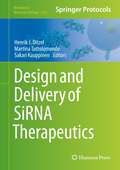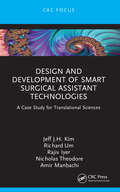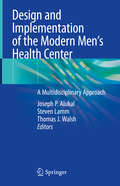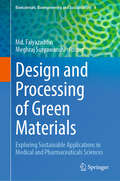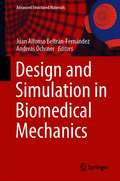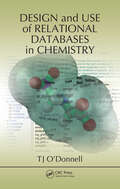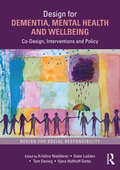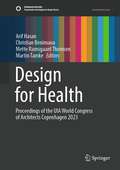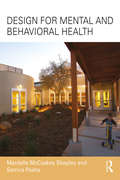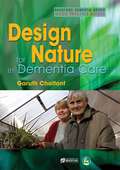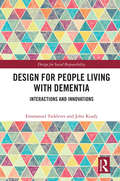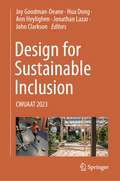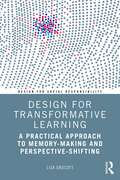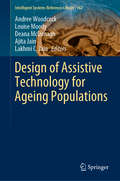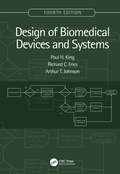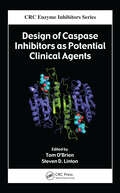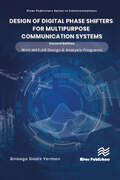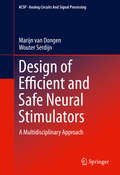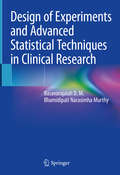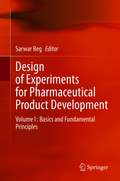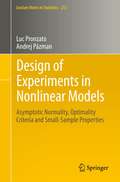- Table View
- List View
Design and Applications of Nanoparticles in Biomedical Imaging
by Jeff W.M. Bulte Michel M.J. ModoThis book covers the state-of-the-art technology of using nanoparticles in biomedical imaging, including magnetic resonance imaging, nuclear medicine, ultrasound imaging, computed tomography, and optical imaging. Topics include nanoparticles for magnetic particle imaging (MRI), siRNA delivery, theranostic nanoparticles and PET imaging of drug delivery, US nanoparticles for drug delivery, inorganic nanoparticles for targeted CT imaging, and quantum dots. This book serves as a valuable resource on the fundamental science of diagnostic nanoparticles in their interactions with biological targets, providing a platform technology for clinical implementation and improved detection of disease. This book also: Broadens readers' understanding of optical imaging, including fluorescent nanoparticles for the visualization of protein trafficking and hyperspectral microscopy using colloidal quantum dots Covers the latest developments in computing tomography, from inorganic nanoparticles for targeted CT imaging to metal-based nanoparticles for CT imaging Shares many insights into the state-of-the-art in ultrasound imaging, such as US bubbles, cell tracking and US nanoparticles for drug delivery Enriches readers' understanding of the most up-to-date technology in using PET nanoparticles to target tumor metastasis, PET imaging of drug delivery, and Nanoparticles for magnetic particle imaging (MRI)
Design and Delivery of SiRNA Therapeutics (Methods in Molecular Biology #2282)
by Henrik J. Ditzel Martina Tuttolomondo Sakari KauppinenThis volume details protocols on rationale design of therapeutic siRNA molecules and its encapsulation with smart vehicles to overcome the barriers to an effective administration in vivo. Written in the highly successful Methods in Molecular Biology series format, chapters include introductions to their respective topics, lists of the necessary materials and reagents, step-by-step, readily reproducible laboratory protocols, and tips on troubleshooting and avoiding known pitfalls. Authoritative and cutting-edge, Design and Delivery of SiRNA Therapeutics aims to ensure successful results in the further study of this vital field.
Design and Development of Smart Surgical Assistant Technologies: A Case Study for Translational Sciences
by Amir Manbachi Jeff J.H. Kim Richard Um Rajiv R. Iyer Nicholas TheodoreAre Amazon Alexa and Google Home limited to our bedrooms, or can they be used in hospitals? Do you envision a future where physicians work hand-in-hand with voice AI to revolutionize healthcare delivery? In the near future, clinical smart assistants will be able to automate many manual hospital tasks—and this will be only the beginning of the changes to come. Voice AI is the future of physician-machine interaction and this Focus book provides invaluable insight on its next frontier. It begins with a brief history and current implementations of voice-activated assistants and illustrates why clinical voice AI is at its inflection point. Next, it describes how the authors built the world’s first smart surgical assistant using an off-the-shelf smart home device, outlining the implementation process in the operating room. From quantitative metrics to surgeons’ feedback, the authors discuss the feasibility of this technology in the surgical setting. The book then provides an in-depth development guideline for engineers and clinicians desiring to develop their own smart surgical assistants. Lastly, the authors delve into their experiences in translating voice AI into the clinical setting and reflect on the challenges and merits of this pursuit. The world’s first smart surgical assistant has not only reduced surgical time but eliminated major touch points in the operating room, resulting in positive, significant implications for patient outcomes and surgery costs. From clinicians eager for insight on the next digital health revolution to developers interested in building the next clinical voice AI, this book offers a guide for both audiences.
Design and Implementation of the Modern Men’s Health Center: A Multidisciplinary Approach
by Steven Lamm Thomas J. Walsh Joseph P. AlukalThis book outlines the approach to comprehensive men’s health deployed at three of the most successful American men’s health centers. It demonstrates the ways in which multidisciplinary care allows patients to easily access their doctors via coordination of care, same day add-on visits, and streamlining of office logistics such as sharing of charts, reports, and results. Guiding readers in establishing an evidence-based, multidisciplinary approach to the management of male patients of all ages, this volume shows how prevention, rapid intervention, cost efficiency, and coordinated care are at the forefront of a health center’s care strategy. The authors of this volume are thought leaders in the disciplines of cardiology, gastroenterology, dermatology, psychiatry, and preventative medicine.Design and Implementation of the Modern Men’s Health Center: A Multidisciplinary Approach enables urologists, medical subspecialists, and surgical subspecialists to both manage basic patient issues and also to understand how multidisciplinary care enables the success of a men’s health center.
Design and Processing of Green Materials: Exploring Sustainable Applications in Medical and Pharmaceuticals Sciences (Biomaterials, Bioengineering and Sustainability #4)
by Md. Faiyazuddin Meghraj SuryawanshiThis book offers a comprehensive view of the creation and use of natural polysaccharides by integrating sustainability, bioengineering, and green materials in a unique way. With an in-depth coverage, it includes a thorough analysis of natural polysaccharides, delving into their synthesis, characteristics, and range of emerging technology applications, as well as guidance to researchers and practitioners who aim to reduce environmental effects by highlighting eco-friendly design concepts and sustainable manufacturing techniques. Highlighting the potential and adaptability of natural polysaccharides, ranging from eco-friendly packaging materials to medicinal innovations such as tissue engineering and drug delivery systems, this book provides useful information on the practical applications of natural polysaccharides in the real world, encouraging creativity and problem solving through case studies and practical examples.
Design and Simulation in Biomedical Mechanics (Advanced Structured Materials #146)
by Andreas Öchsner Juan Alfonso Beltrán-FernándezThis book integrates bioengineering for solving health issues. It shows how the use of applied mechanics and strength of materials using 3D printing models, digital correlation techniques and computed tomography images, provides solutions to biology, medicine and mechanical engineering. The book provides clear processes and illustrations, several worked examples, and many projects. It helps scientists to analyze different modes of applying mechanical and biomedical concepts, physical principles to develop devices, sensors, prosthesis, orthotic systems, new materials and techniques that may improve the health system. It can be used in courses such as biomechanics and orthopedics, rehabilitation and mechanical engineering, also in rehabilitation or sports medicine.
Design and Use of Relational Databases in Chemistry
by TJ O'DonnellOptimize Your Chemical DatabaseDesign and Use of Relational Databases in Chemistry helps programmers and users improve their ability to search and manipulate chemical structures and information, especially when using chemical database "cartridges". It illustrates how the organizational, data integrity, and extensibility properties of relational dat
Design for Dementia, Mental Health and Wellbeing: Co-Design, Interventions and Policy (Design for Social Responsibility)
by Kristina Niedderer, Geke Ludden, Tom Dening and Vjera Holthoff-DettoThis edited volume offers the first overview and reflective discussion of how design can contribute to people’s wellbeing and mental health in the context of dementia, mental illness and neurodiversity. This book explores and promotes holistic, salutogenic and preventive strategies that recognise and respond to people’s needs, wants, wishes and rights to further health, wellbeing and equality. Bringing together years of experience as designers and clinicians, the contributors to the book emphasise how design can be a collaborative, creative process as well as an outcome of this process, and they reveal how this is guided by mental health and design policy. Through its three parts, the book explores themes of ethics, citizenship and power relationships in co-design, providing an overview of current developments and approaches in co-design; of the culturally and value sensitive adaptation of design interventions and their applications, many of which are a result of co-design; and of policy and related standards in and for design and mental health. In this way, the book demonstrates how design can help to support people, their care partners and care professionals in promoting mental health and wellbeing, and it offers a rich resource on how to create a sustainable future for care in this domain. The book provides a unique and holistic overview and resource for designers, researchers, students, policy providers and health and care professionals to help support the development and adoption of person-centred design processes and interventions.
Design for Health: Proceedings of the UIA World Congress of Architects Copenhagen 2023 (Sustainable Development Goals Series)
by Mette Ramsgaard Thomsen Martin Tamke Arif Hasan Christian BenimanaThe book provides new perspectives from leading researchers accentuating and examining the central role of the built environment in conceiving and implementing multifaceted solutions to the complex challenges of physical and mental health, revealing critical potentials for architecture and design to contribute in more informed and long-term ways to the urgent transition of our society. The volume book offers a compilation of peer-reviewed papers that uniquely connects knowledge and criticality broadly across practice and academia; from new technologies, theories, and methods to community -engaged practice on many scales, and more. The book is part of a series of six volumes that explore the agency of the built environment in relation to the SDGs through new research conducted by leading researchers. The series is led by editors Mette Ramsgaard Thomsen and Martin Tamke in collaboration with the theme editors: - Design for Climate Adaptation: Billie Faircloth and Maibritt Pedersen Zari- Design for Rethinking Resources: Carlo Ratti and Mette Ramsgaard Thomsen (Eds.)- Design for Resilient Communities: Anna Rubbo and Juan Du (Eds.)- Design for Health: Arif Hasan and Christian Benimana (Eds.)- Design for Inclusivity: Magda Mostafa and Ruth Baumeister (Eds.)- Design for Partnerships for Change: Sandi Hilal and Merve Bedir (Eds.)
Design for Mental and Behavioral Health
by Mardelle McCuskey Shepley Samira PashaStudies confirm that the physical environment influences health outcomes, emotional state, preference, satisfaction and orientation, but very little research has focused on mental and behavioural health settings. This book summarizes design principles and design research for individuals who are intending to design new mental and behavioural health facilities and those wishing to evaluate the quality of their existing facilities. The authors discuss mental and behavioural health systems, design guidelines, design research and existing standards, and provide examples of best practice. As behavioural and mental health populations vary in their needs, the primary focus is limited to environments that support acute care, outpatient and emergency care, residential care, veterans, pediatric patients, and the treatment of chemical dependency.
Design for Nature in Dementia Care
by Garuth ChalfontMaintaining a connection to nature is increasingly recognised as an important component of caring for a person with dementia. Design for Nature in Dementia Care provides comprehensive examples of ways to connect to nature through indoor and outdoor activities. The author describes a wide range of activities that offer a connection to nature, such as caring for house plants and pets, gardening and cooking, practising handicrafts and domestic chores. He suggests practical ways to incorporate nature into indoor and outdoor environments and also into the design of buildings and landscapes. These suggestions are drawn from interdisciplinary research in environmental psychology, neurology, architecture, nursing and dementia care practice. This book is a practical resource for care providers and design professionals who want to use nature to improve the lives of people with dementia.
Design for Pediatric and Neonatal Critical Care
by Mardelle McCuskey ShepleyDesign for Pediatric and Neonatal Critical Care provides an overview of the design and research issues associated with the development of environments for pediatric and neonatal intensive care. This is the first and only book dedicated to this topic and was created to support individuals interested in developing and studying critical care environments for children and their families. In addition to a detailed analysis of the literature from research and practice, the author provides a summary of the historical development of critical care for infants and children, and information regarding the role of PICUs and NICUs in the critical care system. A discussion of current codes and future trends is also provided. Design for Pediatric and Neonatal Critical Care includes essays from prominent voices in the field ranging from inspired young architects and researchers to world-renowned healthcare design and research icons. Illustrations of work that has been identified as exemplary or representative of recent directions are included, which will help those planning new or remodeled projects to identify and examine precedents. This book is intended to help designers and researchers enhance healing environments for young patients in critical care settings and provide information in support of the families and staff who provide care for these children and infants.
Design for People Living with Dementia: Interactions and Innovations (Design for Social Responsibility)
by John Keady Emmanuel TseklevesThere were an estimated 50 million people worldwide living with dementia in 2017 and this number will almost double every 20 years, reaching 75 million in 2030. Design has significant potential to contribute to managing this global concern. This book is the first to synthesise the considerable research and projects in dementia and design. Design interactions is a new way of considering how we can improve the relationship between people, products, places and services and of course technology trends, such as the ‘internet of things’, offer great opportunities in providing new ways to connect people with services and products that can contribute to healthier lifestyles and mechanisms to support people with acute and chronic conditions. In light of this, the book explores the contribution and future potential of design for dementia through the lens of design interactions, such as people, contexts, material and things. Design for People Living with Dementia is a guide to this innovative and cutting-edge field in healthcare. This book is essential reading for healthcare managers working to provide products, services and care to people with dementia, as well as design researchers and students. .
Design for Sustainable Inclusion: CWUAAT 2023
by John Clarkson Jonathan Lazar Ann Heylighen Hua Dong Joy Goodman-DeaneThis book, Design for Sustainable Inclusion, was inspired and informed by the United Nations Sustainable Development Goals. These include, among others, ‘good health and well-being’, ‘reduced inequalities’ and ‘sustainable cities and communities’. Addressing this challenge requires a cross-disciplinary approach and close collaboration with many stakeholders. The Cambridge Workshop on Universal Access and Assistive Technology (CWUAAT) 2023 invited participants from a wide variety of disciplines to contribute to the discussion on this topic.This book represents the papers presented at this conference, chosen by peer review by an international panel of currently active researchers. The chapters within the book provide a unique insight into current national and international research in the fields of inclusive design, universal access, and assistive and rehabilitative technology. The main sections of the book reflect the following key themes:• Understanding people• Designing for an ageing population• Inclusive built environments• Healthcare• Assistive technology• Design methods• Education and trainingWe hope that this book will be useful to researchers, teachers, students and the general public who are interested in inclusive design and sustainable development.
Design for Transformative Learning: A Practical Approach to Memory-Making and Perspective-Shifting (Design for Social Responsibility)
by Lisa GrocottThe creative strategies in Design for Transformative Learning offer a playful and practical approach to learning from and adapting to a rapidly changing world. Seeing continuous learning as more than the periodic acquisition of new skills this book presents a design-led approach to revising the stories we tell ourselves, unlearning old habits and embracing new practices. This book maps learning opportunities across the contemporary landscape, narrating global case studies from K12, higher education, design consultancies and researchers. It offers narrative context, best practices and emergent strategies for how designers can partner in the important work of advancing a lifetime of learning. Committed to driving sustained transformation this is a playbook of practical moves for designing memory-making, perspective-shifting, hands-on learning encounters. The book braids stories from design practice with theories of change, transformative learning literature, cognitive and social psychology research, affect theory and indigenous knowing. Positioning the COVID-19 pandemic as a moment to question what was previously normalised, the book proposes playful strategies for seeding transformational change. The relational practice at the core of Design for Transformative Learning argues that if learning is to be transformative the experience must be embodied, cognitive and social. This book is an essential read for design and social innovation researchers, facilitators of community engagement and co-design workshops, design and arts educators and professional learning designers. It is a useful primer for K12 teachers, organisational change practitioners and professional development facilitators curious to explore the intersection of design and learning.
Design of Assistive Technology for Ageing Populations (Intelligent Systems Reference Library #167)
by Lakhmi C. Jain Louise Moody Andree Woodcock Deana McDonagh Ajita JainThis book focuses on various aspects of research on aging, including in relation to assistive technology; dignity of aging; how technology can support a greater understanding of the experience of physically aging and cognitive changes; mobility issues associated with the elderly; and emerging technologies. The 80+ age group represents an expanding market, with an estimated worth of £21.4 billion a year. Everyone is affected by this shift in demographics – we are getting older and may become carers – and we need to prepare ourselves and adjust our surroundings for longer life. Products, services and environments have been changing in response to the changing population. Presenting international design research to demonstrate the thinking and ideas shaping design, this book is a valuable resource for designers; product developers; employers; gerontologists; and medical, health and service providers; as well as everyone interested in aging.
Design of Biomedical Devices and Systems, 4th edition
by Paul H. King Richard C. Fries Arthur T. JohnsonThis will be a substantial revision of a highly regarded text, intended for senior design capstone courses within departments of biomedical engineering, bioengineering, biological engineering and medical engineering, worldwide. Each chapter will be thoroughly updated and revised to reflect the latest developments. New material will be added on entrepreneurship, bioengineering statistics, clinical trials and CRISPR. New examples, applications and problems will be added in each chapter.There will be strong efforts made to increase the number of clinical applications to enhance the overall relevance of the material that's presented. Significant new material added on FDA regulations.
Design of Caspase Inhibitors as Potential Clinical Agents
by Tom O’Brien Steven D. LintonPresents the Therapeutic Potential for Caspase Inhibitors: Present and FutureCaspases represent one of the most specific protease families described to date. These extremely important enzymes are crucial to the destruction of aberrant cells - the body's self-protection mechanism for warding off the growth of abnormal cells, many of which can promot
Design of Digital Phase Shifters for Multipurpose Communication Systems
by Binboga Siddik YarmanThis book aims to cover a new emerging need in designing digital phase shifter for modern communication systems. With the advancement of new generation mobile communication systems, directed beams of antenna arrays save a substantial amount of power as well as improve the communication quality. In this regard, beam-forming circuits, such as digital phase shifters (DPS) constitute essential parts of the antenna array systems. Therefore, this book is devoted to the design of digital phase shifters for various communications systems. Nowadays, phase array systems demand compact phase shifters suitable for chip implementation with wide phase-range and broad frequency band. Each chapter of this book is organized as stand-alone in such a way that the reader requires no specific background acquired from the other chapters. For each phase shifter topology introduced in this book, the reader is furnished with explicit design equations to construct the circuit under consideration. Furthermore, design equations are programmed using MATLAB to assess the electrical performance of the phase shifters with ideal and lossy components. MATLAB design programs are given at the and of each chapter as appendices and provided as soft copy on the web page of the book. In chapters 12 and 14, MMIC layouts for the lattice and T-section based DPS are provided for the readers. It is hoped that an interested reader can immediately identifies the “optimum phase shifter topology” for the need under consideration with its estimated electric performance.
Design of Efficient and Safe Neural Stimulators
by Marijn Van Dongen Wouter SerdijnThis book discusses the design of neural stimulator systems which are used for the treatment of a wide variety of brain disorders such as Parkinson's, depression and tinnitus. Whereas many existing books treating neural stimulation focus on one particular design aspect, such as the electrical design of the stimulator, this book uses a multidisciplinary approach: by combining the fields of neuroscience, electrophysiology and electrical engineering a thorough understanding of the complete neural stimulation chain is created (from the stimulation IC down to the neural cell). This multidisciplinary approach enables readers to gain new insights into stimulator design, while context is provided by presenting innovative design examples.
Design of Experiments and Advanced Statistical Techniques in Clinical Research
by Bhamidipati Narasimha Murthy Basavarajaiah D. M.Recent Statistical techniques are one of the basal evidence for clinical research, a pivotal in handling new clinical research and in evaluating and applying prior research. This book explores various choices of statistical tools and mechanisms, analyses of the associations among different clinical attributes. It uses advanced statistical methods to describe real clinical data sets, when the clinical processes being examined are still in the process. This book also discusses distinct methods for building predictive and probability distribution models in clinical situations and ways to assess the stability of these models and other quantitative conclusions drawn by realistic experimental data sets. Design of experiments and recent posthoc tests have been used in comparing treatment effects and precision of the experimentation. This book also facilitates clinicians towards understanding statistics and enabling them to follow and evaluate the real empirical studies (formulation of randomized control trial) that pledge insight evidence base for clinical practices. This book will be a useful resource for clinicians, postgraduates scholars in medicines, clinical research beginners and academicians to nurture high-level statistical tools with extensive scope.
Design of Experiments for Pharmaceutical Product Development: Volume I : Basics and Fundamental Principles
by Sarwar BegThis book volume provides complete and updated information on the applications of Design of Experiments (DoE) and related multivariate techniques at various stages of pharmaceutical product development. It discusses the applications of experimental designs that shall include oral, topical, transdermal, injectables preparations, and beyond for nanopharmaceutical product development, leading to dedicated case studies on various pharmaceutical experiments through illustrations, art-works, tables and figures. This book is a valuable guide for all academic and industrial researchers, pharmaceutical and biomedical scientists, undergraduate and postgraduate research scholars, pharmacists, biostatisticians, biotechnologists, formulations and process engineers, regulatory affairs and quality assurance personnel.
Design of Experiments for Pharmaceutical Product Development: Volume II : Applications and Practical Case studies
by Sarwar BegThis book volume provides complete and updated information on the applications of Design of Experiments (DoE) and related multivariate techniques at various stages of pharmaceutical product development. It discusses the applications of experimental designs that shall include oral, topical, transdermal, injectables preparations, and beyond for nanopharmaceutical product development, leading to dedicated case studies on various pharmaceutical experiments through illustrations, art-works, tables and figures. This book is a valuable guide for all academic and industrial researchers, pharmaceutical and biomedical scientists, undergraduate and postgraduate research scholars, pharmacists, biostatisticians, biotechnologists, formulations and process engineers, regulatory affairs and quality assurance personnel.
Design of Experiments in Nonlinear Models
by Luc Pronzato Andrej PázmanDesign of Experiments in Nonlinear Models: Asymptotic Normality, Optimality Criteria and Small-Sample Properties provides a comprehensive coverage of the various aspects of experimental design for nonlinear models. The book contains original contributions to the theory of optimal experiments that will interest students and researchers in the field. Practitionners motivated by applications will find valuable tools to help them designing their experiments. The first three chapters expose the connections between the asymptotic properties of estimators in parametric models and experimental design, with more emphasis than usual on some particular aspects like the estimation of a nonlinear function of the model parameters, models with heteroscedastic errors, etc. Classical optimality criteria based on those asymptotic properties are then presented thoroughly in a special chapter. Three chapters are dedicated to specific issues raised by nonlinear models. The construction of design criteria derived from non-asymptotic considerations (small-sample situation) is detailed. The connection between design and identifiability/estimability issues is investigated. Several approaches are presented to face the problem caused by the dependence of an optimal design on the value of the parameters to be estimated. A survey of algorithmic methods for the construction of optimal designs is provided.
Design of Soft–Rigid Devices for Rehabilitative and Assistive Robotics (Springer Theses)
by Mihai DragusanuThis book describes a comprehensive research project in which different devices for rehabilitation, assistance, and haptic applications are designed and developed. The fil-rouge is the user-centered perspective, that has been employed in all the design and development phases, and the exploitation of soft robotics solutions allowing for a safe and comfortable interaction with the user. Extensive information concerning the design, the practical application and the assessment of various assistive devices for upper limb are included throughout the book, which also offers an up-to-date reference guide for dealing with future interdisciplinary research projects involving soft robotics and user-centered perspectives for enhancing robotic assistance capabilities

